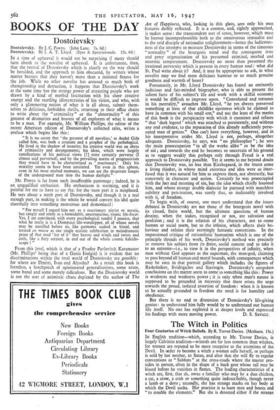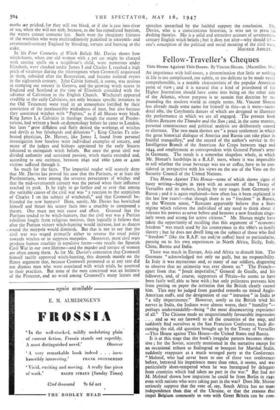The Witch in Politics
Four Centuries of Witch Beliefs. By R. Trevor Davies. (Methuen. 15s.)
IN English tradition—which, according to Mr. Trevor Davies, is largely Calvinist tradition—wizards are far less common than witches, for women are reputed to be more receptive to the attentions of the Devil. In order to become a witch a woman sells herself, or perhaps is sold by her mother, to Satan, and after that she will fly to regular conventions or " Sabbats" at the cross-roads where the master pre- sides in person, often in the shape of a buck goat whose tail may be kissed before he vanishes in flames. The leading characteristics of a witch are, first, that sh_ owns a familiar who may be a dun chicken, a cat, a crow, a crab or something quite indescribable, though never a lamb or a dove ; secondly, she has strange marks on her body at which the Devil sucks. Her practice is to hunt men and beasts and "to trouble the elements." But she is detected either if the strange marks are pricked, for they will not bleed, or if she is cast into river or sea, when she will not sink, because, as she has repudiated baptism, the waters cannot consume her. Such were the imaginary features of the wretches who were multitudinously punished in sixteenth- and seventeenth-century England by blooding, torture and burning ar the stake.
In his Four Centuries of Witch Beliefs Mr. Davies shows how witch-hunts, when any old woman with a pet cat might be charged with casting spells on a neighbour's child, were numerous under Elizabeth, were checked under James I and Charles I, reached a high pitch of virulence during the interregnum when Cromwell acquiesced in them, subsided after the Restoration, and became isolated events in the eighteenth century. John Calvin himself, it seems, was zealous in stamping out sorcery in Geneva, and the growing witch scares in England and Scotland at the time of Elizabeth coincided with the advance of Calvinism in the English Church. Witchcraft appeared credible to the early Calvinists, not only because specific instances in the Old Testament were read in an atmosphere fortified by their' conviction of the inexhaustible wickedness of man, but also because they associated witches with "Papists," as if all Masses were black. King James I, a Calvinist in theology though the enemy of Presby- terians, had writtea a book on demonology before he came to London, but later " grew diffident and flatly denied the workings of witches and devils as but falsehqods and delusions " ; King Charles I's cele- brated physician, Dr. Harvey, like James I, found from personal investigation how baseless were individual examples of sorcery, and many of the judges and bishops appointed by the early Stuarts laboured to extinguish witch beliefs. But once the great civil war divided authority and sustained passion, witch mania extended and, according to one estimate, between 1640 and 1660 3,000 or 4,000 victims suffered through it.
So much for the facts. The impartial reader will scarcely deny that Mr. Davies has proved his case that the Puritans, or at least the Presbyterians, were among the severest persecutors of witches and that the mid-seventeenth century was the period when their influence reached its peak. Is he right to go farther and to aver that among the veritable causes of the civil war was " a reaction to the scepticism of Charles I on the subject of witchcraft," and that Cromwell be- friended the new hunters? Here, surely, Mr. Davies has bewitched himself and thrust his scanty facts into a crucible to compound a theory. One must not mix cause and effect. Granted that the Puritans tended to be witch-hunters, that the civil war was a Puritan rebellion fought from religious motives, then logically it follows that after the Puritan victory witch-hunting would increase, just as dances round the maypole would diminish, But that is not to say that the civil war was waged primarily either to reverse the royal policy towards witches or to suppress maypoles. Moreover, most civil wars produce human cruelties in repulsive forms—one recalls the Spanish Civil War in our own lifetime—and the murder and torture of women are often among them. As for Mr. Davies's contention that Cromwell himself tacitly approved witch-hunting, this depends mainly on the flimsy argument that, because Cromwell promoted or at any rate did not dismiss men who were associated with witch trials, he assented to their practices. But none of the men concerned was an intimate of the Protector, and no word among Cromwell's many letters and speeches unearthed by the faithful support the conclusion. Mr. Davies, who is a conscientious historian, is wise not to press his dashing theories. His is a solid and attractive account of seventeenth- century English witch beliefs ; but it does not alter—why should it?— one's conception of the political and social meaning of the civil wars.
MAURICE ASHLEY.



































 Previous page
Previous page